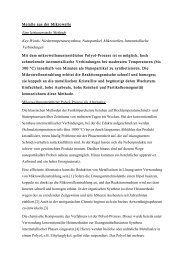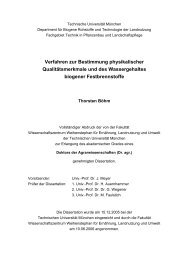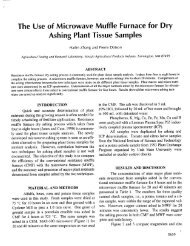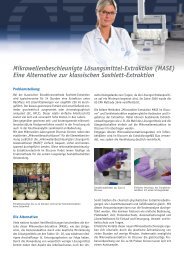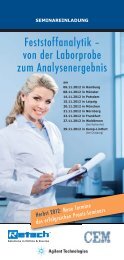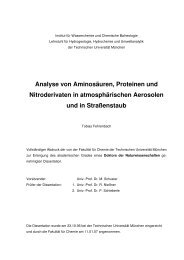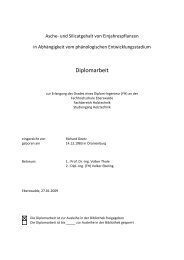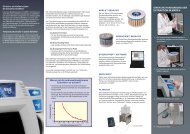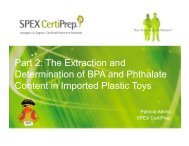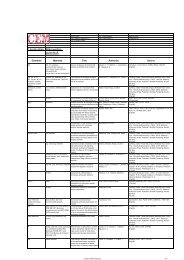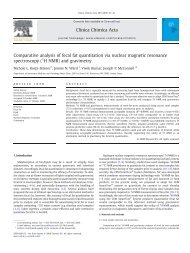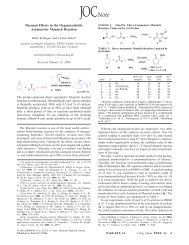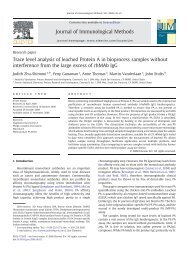Microwave-assisted extraction versus Soxhlet ... - CEM GmbH
Microwave-assisted extraction versus Soxhlet ... - CEM GmbH
Microwave-assisted extraction versus Soxhlet ... - CEM GmbH
Create successful ePaper yourself
Turn your PDF publications into a flip-book with our unique Google optimized e-Paper software.
Abstract<br />
Journal of Chromatography A, 1046 (2004) 19–26<br />
<strong>Microwave</strong>-<strong>assisted</strong> <strong>extraction</strong> <strong>versus</strong> <strong>Soxhlet</strong> <strong>extraction</strong> for the<br />
analysis of short-chain chlorinated alkanes in sediments <br />
J. Parera, F.J. Santos, M.T. Galceran ∗<br />
Departament de Química Analítica, Universitat de Barcelona, Diagonal 647, 08028 Barcelona, Spain<br />
Received 8 March 2004; received in revised form 2 June 2004; accepted 23 June 2004<br />
<strong>Microwave</strong>-<strong>assisted</strong> <strong>extraction</strong> (MAE) was evaluated as a possible alternative to <strong>Soxhlet</strong> <strong>extraction</strong> for analysing short-chain chlorinated<br />
alkanes (commonly called short-chain chlorinated paraffins, SCCPs) in river sediment samples, using gas chromatography coupled to negative<br />
chemical ionisation mass spectrometry. For MAE optimisation, several <strong>extraction</strong> parameters such as solvent <strong>extraction</strong> mixture, <strong>extraction</strong><br />
time and <strong>extraction</strong> temperature were studied. Maximum <strong>extraction</strong> efficiencies for SCCPs (90%) and for 12 polychlorinated biphenyl (PCB)<br />
congeners (91–95%) were achieved using 5 g of sediment sample, 30 ml of n-hexane–acetone (1:1, v/v) as solvent <strong>extraction</strong>, and 15 min<br />
and 115 ◦ C of <strong>extraction</strong> time and temperature, respectively. Activated Florisil was used to clean-up the extracts, allowing highly selective<br />
separation of SCCPs from other organic contaminants such as PCBs. MAE was compared with a conventional <strong>extraction</strong> technique such<br />
as <strong>Soxhlet</strong> and good agreement in the results was obtained. Quality parameters of the optimised MAE method such as run-to-run (R.S.D.<br />
7%) and day-to-day precision (R.S.D. 9%) were determined using spiked river sediment samples, with LODs of 1.5 ng g −1 . This method was<br />
successfully applied to the analysis of SCCPs in river sediment samples at concentrations below the ng g −1 level.<br />
© 2004 Elsevier B.V. All rights reserved.<br />
Keywords: Sediments; Environmental analysis; <strong>Microwave</strong>-<strong>assisted</strong> <strong>extraction</strong>; Extraction methods; Alkanes; Organochlorine compounds; Polychlorinated<br />
biphenyls<br />
1. Introduction<br />
Chlorinated alkanes (also called chlorinated paraffins,<br />
CPs) are complex industrial mixtures formed by direct chlorination<br />
of n-alkane feedstocks under forcing conditions of<br />
temperature and UV–vis irradiation [1–4]. These formulations<br />
contain a high number of isomers and homologues of<br />
polychlorinated n-alkanes (PCAs), with carbon chain lengths<br />
between 10 and 30 and a chlorination degree between 30<br />
and 70% (w/w) [5]. Depending on the carbon chain length,<br />
CPs can be classified into three group of compounds: shortchain<br />
(C10–13, SCCPs), medium-chain (C14–17, MCCPs) and<br />
Presented at the 3rd Meeting of the Spanish Association of Chromatography<br />
and Related Techniques and the European Workshop: 3rd Waste Water<br />
Cluster, Aguadulce, Almeria, 19–21 November 2003.<br />
∗ Corresponding author. Tel.: +34 93 402 12 75; fax: +34 93 402 12 33.<br />
E-mail address: galceran@apolo.qui.ub.es (M.T. Galceran).<br />
0021-9673/$ – see front matter © 2004 Elsevier B.V. All rights reserved.<br />
doi:10.1016/j.chroma.2004.06.064<br />
long-chain (C18–30, LCCPs) chlorinated alkanes (CPs). Due<br />
to their physical and chemical properties, CPs are used as<br />
additives in plastics, paints and cutting oils and as flame retardants<br />
[6–7]. Of the different CP formulations, short-chain<br />
(C10–C13) CPs are the most extensively used mixture in the<br />
industry [8]. In the 1970s, the United States Environmental<br />
Protection Agency (EPA) and the Chlorinated Paraffins Industry<br />
Association (CPIA) undertook a comprehensive study<br />
of the health and environmental impact of CPs and in 1990 the<br />
International Agency for Research of Cancer (IARC) classified<br />
short-chain CPs (C12) with an average chlorine content<br />
of 60% as possibly carcinogenic to humans (group 2B) [9].<br />
However, no evidence of carcinogenicity was found in the<br />
other commercial mixtures of CPs (MCCPs and LCCPs). The<br />
result was that several organisations (Oslo and Paris Commission<br />
for the Protection of the Marine Environment for the<br />
North-East Atlantic: OSPAR, Canadian Environmental Protection<br />
Act: CEPA) and environmental protection agencies
20 J. Parera et al. / J. Chromatogr. A 1046 (2004) 19–26<br />
listed SCCPs as substances requiring special action and regulations<br />
[10,11]. The European Union [12] has recently included<br />
SCCPs [13] on its list of priority hazardous substances<br />
in the field of water policy, amending Directive 2000/60/EC<br />
[14].<br />
The presence of CPs in various environmental matrices<br />
such as biota [8,15,16], sediments [3,15,17,22], air [18] and<br />
water [19–23] has been reported, but information about environmental<br />
levels is still limited. CPs have been detected<br />
in river and marine sediments from industrial zones at concentration<br />
levels between 0.2 and 65 gg −1 , while in lake<br />
and river sediments of remote or agricultural areas CPs are<br />
found at concentrations from 10 to 250 ng g −1 . Generally,<br />
the analysis of CPs is difficult due to the large number of<br />
congeners (a minimum of several thousands) present in technical<br />
products. Furthermore, single-capillary GC column is<br />
by far insufficient to separate all the compounds, as individual<br />
peaks and the chromatograms obtained are characterised by<br />
a broad profile corresponding to a large number of co-eluting<br />
peaks [4]. Most of the methods used for the determination of<br />
CPs are based on gas chromatography with electron-capture<br />
detection [23–25] (GC–ECD) or coupled to high- or lowresolution<br />
mass spectrometry. Detection of CPs using mass<br />
spectrometry frequently involves electron-capture negative<br />
ionisation (ECNI), due to its high selectivity and sensitivity<br />
[3,8,26,27].<br />
Few papers on the analysis of CPs in solid matrices, e.g.<br />
soils, sediments and sludges, have been published. Most of<br />
the methods used in these studies are based on classical <strong>Soxhlet</strong><br />
<strong>extraction</strong>. Nevertheless, this traditional sample <strong>extraction</strong><br />
technique often uses large quantities of organic solvents<br />
and is usually time-consuming. In the last few years, established<br />
methods, such as supercritical fluid <strong>extraction</strong> (SFE),<br />
pressurized liquid <strong>extraction</strong> (PLE) and microwave-<strong>assisted</strong><br />
<strong>extraction</strong> (MAE), were used to reduce the volume of solvents<br />
required, to improve the precision of analyte recoveries<br />
and to reduce <strong>extraction</strong> time. Of these techniques,<br />
SFE is the most selective <strong>extraction</strong> method, but its use<br />
has been limited by the strong matrix dependence of the<br />
<strong>extraction</strong> process. Most of the time, <strong>extraction</strong> conditions<br />
need to be optimised for each new matrix [28]. PLE and<br />
MAE techniques offer advantages over the SFE method, but<br />
to date accelerated solvent <strong>extraction</strong> is the only technique<br />
used for the isolation of CPs from soil and sediment samples<br />
[15,17,24]. Nevertheless, microwave-<strong>assisted</strong> <strong>extraction</strong><br />
can be an excellent alternative sample preparation technique<br />
for the <strong>extraction</strong> of CPs. In fact, this technique has been<br />
successfully applied to the analysis of environmental pollutants<br />
such as hydrocarbons [29], organochlorine pesticides<br />
[29–35], polychlorinated biphenyls [35–40], polychlorinated<br />
aromatic hydrocarbons [31,41–45], phenols [41,46], from<br />
soil and sediment matrices.<br />
This paper focuses on the development of a new method<br />
for the analysis of SCCPs in sediment, using microwave<strong>assisted</strong><br />
<strong>extraction</strong> and gas chromatography–electron-capture<br />
negative ion-mass spectrometry (GC–ECNI-MS). For this<br />
purpose, MAE parameters, such as <strong>extraction</strong> temperature,<br />
<strong>extraction</strong> time and the composition of the <strong>extraction</strong> solvent,<br />
were optimised in order to maximize the <strong>extraction</strong><br />
efficiency of SCCPs and other environmental contaminants<br />
such as polychlorinated biphenyls present in sediment samples.<br />
The optimised method was evaluated by comparing the<br />
results with those obtained with <strong>Soxhlet</strong> <strong>extraction</strong>. Quality<br />
parameters for both methods were established, and the proposed<br />
method was used for the determination of SCCPs and<br />
polychlorinated biphenyls (PCBs) in river sediment samples.<br />
2. Experimental<br />
2.1. Standards and reagents<br />
Two stock standard solutions of a short-chain chlorinated<br />
paraffin (SCCP, C10–C13, 63% Cl) in acetone and in<br />
cyclohexane of 100 ng l −1 were obtained from Dr. Ehrenstorfer<br />
<strong>GmbH</strong> (Augsburg, Germany). Individual analyticalreagent<br />
grade PCB congeners, 28, 52, 101, 105, 118, 128,<br />
138, 149, 153, 156, 170 and 180, at purity higher than 99%,<br />
were supplied by Promochem <strong>GmbH</strong> (Wesel, Germany). A<br />
stock standard solution mixture of the 12 PCB congeners<br />
at 300 gg −1 was prepared by weight in isooctane. Five<br />
calibration standard solutions of SCCPs (between 1 and<br />
80 gg −1 ) and PCBs (from 0.5 to 200 ng g −1 ) containing the<br />
internal standards were prepared by dilution of the primary<br />
standard solutions in isooctane for quantification purposes.<br />
Standard solutions at concentration levels of 10 gg −1 for<br />
the SCCPs and 1 gg −1 for each PCB congener were prepared<br />
for spiking experiments. PCB-30 (1 gg −1 in isooctane)<br />
and [ 13 C6]-hexachlorobenzene (1 gg −1 in isooctane)<br />
(Dr. Ehrenstorfer <strong>GmbH</strong>) were used as internal standards for<br />
quantification of PCB congeners using GC–ECD and of SC-<br />
CPs using GC–ECNI-MS, respectively.<br />
n-Hexane, dichloromethane (DCM), acetone and tertbutyl<br />
methyl ether, of pesticide residue analysis grade,<br />
were purchased from Merck (Darmstadt, Germany). Florisil<br />
(0.150–0.250 mm) for residue analysis, alumina (aluminium<br />
oxide 90 active neutral) and silica gel (0.063–0.2 mm) for column<br />
chromatography were obtained from Merck. Fine copper<br />
powder was purchased from Merck. Copper powder was<br />
activated by nitric acid (1:1, v/v). Anhydrous sodium sulphate<br />
was supplied by Panreac (Barcelona, Spain). Before<br />
use, alumina and silica gel were cleaned with DCM in an ultrasonic<br />
bath for 15 min and were dried in a heater at 120 ◦ C<br />
until elimination of solvent. All adsorbents were activated at<br />
650 ◦ C overnight and stored at 120 ◦ C before use.<br />
2.2. GC–ECD and GC–MS conditions<br />
Preliminary MAE optimisation procedures were performed<br />
with a Trace GC 2000 gas chromatograph<br />
(ThermoFinnigan, Milan, Italy), equipped with a 63 Ni<br />
electron-capture detector and the AS2000 autosampler. For
the chromatographic separation of SCCPs and PCB congeners,<br />
a DB-5 ms (5% phenyl, 95% methylpolysiloxane),<br />
30 m × 0.25 mm i.d., fused-silica capillary column<br />
(J&W Scientific, Folsom, CA, USA) of 0.25 m film thickness<br />
was used. In addition, to confirm PCB congeners, a<br />
DB-17 (50% phenyl-, 50% methylpolysiloxane), 30 m ×<br />
0.25 mm i.d., fused-silica capillary column (J&W Scientific)<br />
of 0.25 m film thickness was used. Helium was used as carrier<br />
gas (38 cm/s at 90 ◦ C), and N2 as ECD make-up gas<br />
(40 ml min −1 ). Injector and ECD temperature were set at<br />
250 and 330 ◦ C, respectively, and the splitless injection mode<br />
(1 min) was used. The oven temperature program for the analysis<br />
of SCCPs using DB-5 ms column was 90 ◦ C (held for<br />
1 min) to 180 ◦ Cat15 ◦ C/min and to 300 ◦ Cat8 ◦ C/min (held<br />
for 10 min). For the analysis of PCBs, the oven programme<br />
for DB-5 ms and DB-17 capillary columns was: 90 ◦ C (held<br />
for 1 min) to 180 ◦ Cat15 ◦ C/min and to 300 ◦ C at 2.5 ◦ C/min.<br />
For quantification purposes, the integration of the total area<br />
below the SCCP elution profile was used.<br />
For the analysis of SCCPs, GC–ECNI-MS experiments<br />
were performed on a Trace GC 2000 chromatograph coupled<br />
to a GCQ/Polaris ion-trap mass spectrometer (ThermoFinnigan,<br />
TX, USA). DB-5 ms fused-silica capillary column was<br />
used and the chromatographic conditions were the same as<br />
described above for GC–ECD experiments. Xcalibur version<br />
1.2 software was used for control, general operation and acquisition<br />
of the mass spectra. The instrument was operated in<br />
the ECNI mode and tuned using perfluorotributylamine (FC-<br />
43), following manufacturer’s directions, in order to achieve<br />
the best sensitivity working with automatic gain control. For<br />
all experiments, electron energy was 70 eV and emission<br />
current 250 A. Ion source and transfer line temperatures<br />
were 200 ◦ C and 275 ◦ C, respectively. Parameters such as<br />
automatic gain control (AGC) target and multiplier voltage<br />
(1450 V, 10 5 gain) were set by automatic tune. Methane was<br />
used as moderating gas and the pressure in the mass analyser<br />
region of the vacuum manifold was measured by means<br />
of an ion gauge. The MS acquisition method was time programmed<br />
in two segments. In the first segment, the internal<br />
standard, [ 13 C6]hexachlorobenzene, was detected by monitoring<br />
the m/z 286–296 region at 0.64 s/scan (10 scan/scan),<br />
whereas SCCPs were monitored in the second segment by<br />
scanning the range m/z 70–75 ([HCl2] − and [Cl2] −• cluster<br />
ions) at 0.63 s/scan (10 scan/scan). SCCPs were quantified<br />
as the sum of total area below the elution profile of SCCPs<br />
obtained in the second monitoring segment.<br />
2.3. <strong>Soxhlet</strong> and microwave-<strong>assisted</strong> <strong>extraction</strong><br />
procedures<br />
For <strong>Soxhlet</strong> <strong>extraction</strong> experiments, an aliquot of 5 g dry<br />
mass sediment sample was placed in a glass <strong>Soxhlet</strong> thimble<br />
containing 20 g of anhydrous sodium sulphate and 20 g of<br />
activated copper powder for sulphur removal. The sample was<br />
extracted with 300 ml of n-hexane–DCM (1:1, v/v) for 16 h.<br />
The organic extract was then concentrated to ca. 1 ml using<br />
J. Parera et al. / J. Chromatogr. A 1046 (2004) 19–26 21<br />
a rotary evaporator without heating. The extract was then<br />
purified following the clean-up procedure described below<br />
(Section 2.4).<br />
<strong>Microwave</strong>-<strong>assisted</strong> solvent <strong>extraction</strong> used a <strong>CEM</strong><br />
MARS 5, microwave sample <strong>extraction</strong> system (<strong>CEM</strong>,<br />
Matthews, NC, USA), equipped with twelve closed vesselmicrowave<br />
<strong>extraction</strong> cells. <strong>Microwave</strong> energy was produced<br />
by a 1200 W magnetron. The <strong>extraction</strong> reactor cells were<br />
made by a closed pressure-resisting system that contains an<br />
inner vessel of Pyrex (“GreenChem”) with a volume of 85 ml<br />
and allows maximum pressure and temperature of 200 psi and<br />
200 ◦ C, respectively (psi = 6894.76 Pa). The inner temperature<br />
of the sample vessel was measured and controlled with<br />
a microwave-inert optical fibre temperature probe, while the<br />
pressure inside the microwave system was measured by a<br />
gauge probe. The sediment samples (5 g) were extracted at<br />
115 ◦ C for 15 min at the maximum magnetron power, using<br />
30 ml of solvent mixture n-hexane–acetone (1:1, v/v). A<br />
PTFE-coated stir bar was used as magnetic stirring of the samples.<br />
After <strong>extraction</strong>, the sample was left for a cooling time<br />
of 20 min. The supernatant organic extract was then carefully<br />
decanted from the <strong>extraction</strong> vessel to a 50 ml heart-shaped<br />
flask and the sample was rinsed with three portions of 5 ml<br />
of n-hexane. All extracts were combined and filtered through<br />
10 g of anhydrous sodium sulphate. For sulphur removal, the<br />
solvent extract was in contact with 20 g of activated copper<br />
for 3 h. Finally, the extract was filtered and concentrated to<br />
ca. 1 ml using a rotary evaporator without heating. The final<br />
extract was then cleaned as described in the clean-up in the<br />
extracts section.<br />
2.4. Clean-up of the extracts<br />
The extracts obtained after sample <strong>extraction</strong> using <strong>Soxhlet</strong><br />
and MAE were carefully transferred to a glass column<br />
(200 mm × 15 mm i.d.) filled with 15 g of activated<br />
Florisil. After packing, the column was rinsed with nhexane<br />
and the entire extract was placed at the top of the<br />
column. Two fractions were collected: (F1) with 60 ml of<br />
n-hexane, where PCBs were eluted, and (F2) with 200 ml nhexane–dichloromethane<br />
(1:1, v/v) which contained the SC-<br />
CPs. The extracts obtained were dried over sodium sulfate<br />
and concentrated to ca. 1 ml using a rotary evaporator. Each<br />
extract was then transferred in a 2-ml vial and was concentrated<br />
under a gentle stream of nitrogen. The final volume<br />
of the extract was adjusted to ca. 150 l with isooctane after<br />
addition of the internal standards ([ 13 C6]hexachlorobenzene<br />
and CB 30). The extracts were analysed by GC–ECD (fraction<br />
1) and GC–ECNI-MS (fraction 2).<br />
2.5. Sediment samples<br />
River sediment samples were collected from six different<br />
sampling points located in several industrial areas of<br />
the Besòs River near Barcelona (NE Spain). All sediment<br />
samples were air-dried, pulverized and sieved through a
22 J. Parera et al. / J. Chromatogr. A 1046 (2004) 19–26<br />
125-mesh sieve. They were stored in the dark at 4 ◦ C until<br />
analysis. A river sediment sample sampled upstream from<br />
the industrial zones (agricultural area) was selected as candidate<br />
blank sediment sample. Before use, this sediment sample<br />
was analysed by GC–ECD to ensure that no compounds or<br />
interest were present. The resulting material was spiked with<br />
adequate amounts of C10–C13 (63% Cl) SCCPs and PCB<br />
congener standard solutions. Before use, it was incubated for<br />
24hat4 ◦ C. The sample was selected as reference spiked sediment<br />
for the optimisation of MAE and clean-up processes.<br />
3. Results and discussion<br />
3.1. Optimisation of clean-up procedure<br />
Preliminary studies were carried out in order to develop<br />
a suitable clean-up method for the purification of sediment<br />
extracts obtained by MAE. For this purpose, sorbents such<br />
as Florisil, silica gel and alumina(15 g), fully activated and<br />
partially deactivated with water (up to 5%, w/w), were studied.<br />
A clean-up procedure based on the elution of two fractions<br />
was used to achieve selective separation of the SCCPs<br />
from other co-extracted compounds, such as PCBs, present<br />
in sediment samples. To elute the less polar compounds (e.g.<br />
PCBs) n-hexane was selected as solvent, whereas for SC-<br />
CPs, solvent mixtures of n-hexane–dichloromethane and nhexane–methyl<br />
tert-butyl ether were tested. To determine the<br />
recovery of the target compounds, a blank river sediment was<br />
spiked at three different concentration levels (200, 300 and<br />
400 ng g −1 for SCCPs, and 2, 3 and 4 ng g −1 for individual<br />
Table 1<br />
Recovery (%) and standard deviation of C10–C13, 63% Cl SCCP and PCB congeners obtained in a spiked sediment sample using different clean-up sorbents<br />
Compound Recovery (%)<br />
Florisil a Silica gel b Alumina c<br />
Activated<br />
(mean ± S.D. d )<br />
1.2% water<br />
(mean ± S.D. d )<br />
Activated<br />
(mean ± S.D. d )<br />
5% water<br />
(mean ± S.D. d )<br />
Activated<br />
(mean ± S.D. d )<br />
SCCPs<br />
PCBs<br />
95 ± 3 70 ± 3 87 ± 2 75 ± 3 nd<br />
CB-28 95 ± 4 78 ± 3 91 ± 2 77 ± 2 88 ± 3<br />
CB-52 93 ± 3 81 ± 2 93 ± 2 78 ± 2 83 ± 3<br />
CB-101 95 ± 2 82 ± 3 90 ± 3 82 ± 3 84 ± 3<br />
CB-105 93 ± 5 81 ± 3 93 ± 3 83 ± 4 81 ± 3<br />
CB-118 90 ± 4 83 ± 3 90 ± 3 82 ± 4 89 ± 3<br />
CB-128 91 ± 6 82 ± 3 91 ± 5 78 ± 3 83 ± 3<br />
CB-138 94 ± 3 82 ± 4 89 ± 2 81 ± 4 86 ± 4<br />
CB-149 93 ± 3 81 ± 3 93 ± 4 83 ± 3 88 ± 4<br />
CB-153 97 ± 4 81 ± 3 87 ± 4 82 ± 3 82 ± 4<br />
CB-156 97 ± 3 78 ± 3 92 ± 2 77 ± 4 83 ± 4<br />
CB-170 94 ± 3 79 ± 3 93 ± 2 84 ± 4 84 ± 3<br />
CB-180 95 ± 3 82 ± 3 90 ± 5 80 ± 3 88 ± 4<br />
nd: not detected (
Table 2<br />
Recovery of C10–C13, 63% Cl SCCP in a sediment sample spiked at concentration<br />
range between 200 and 400 ng g −1 using MAE procedure<br />
Solvent <strong>extraction</strong> mixture Mean (%) a R.S.D. (%)<br />
n-Hexane–dichloromethane (1:1, v/v) 84 7<br />
n-Hexane–acetone (1:1, v/v) 90 8<br />
n-Hexane–acetone (2:1, v/v) 76 7<br />
n-Hexane–acetone (1:2, v/v) 70 7<br />
n-Hexane–methanol (1:2, v/v) 58 8<br />
a n =3.<br />
studied. For this purpose, a blank sediment sample (5 g)<br />
spiked with C10–C13 (63% Cl) SCCPs and the PCB congeners<br />
at three concentration levels between 200–400 and 2-<br />
4ngg −1 , respectively, was used. The samples were extracted<br />
at 115 ◦ C for 30 min using a volume of 30 ml for each solvent<br />
mixture. As n-hexane–dichloromethane do not absorb<br />
microwave energy because the components are not polar, a<br />
microwave absorbing material was added to the <strong>extraction</strong><br />
cell. The extracts were cleaned using the optimised Florisil<br />
method and the two fractions were analysed by GC–ECD<br />
(fraction 1: PCBs) and GC–NCI-MS (fraction 2: SCCPs).<br />
Under these conditions, the highest <strong>extraction</strong> efficiency for<br />
SCCPs (90%) was obtained using n-hexane–acetone (1:1,<br />
v/v) (Table 2). In addition, recoveries ranging from 91 to<br />
95% were achieved for the PCB congeners using this solvent<br />
mixture. Therefore, n-hexane–acetone (1:1, v/v) was chosen<br />
as a suitable solvent mixture for subsequent studies.<br />
After selection of the solvent <strong>extraction</strong> mixture, the <strong>extraction</strong><br />
time and <strong>extraction</strong> temperature were optimised. Initially,<br />
the <strong>extraction</strong> temperature was fixed at 115 ◦ C and the<br />
effect of the <strong>extraction</strong> time on MAE efficiency for all analytes<br />
was examined from 5 to 20 min in 5-min increments.<br />
The recoveries obtained for SCCPs and some PCB congeners<br />
are given in Table 3. The highest recovery for all compounds<br />
was found at 15 min. The effect of the temperature on the<br />
<strong>extraction</strong> efficiency of the SCCPs and PCB congeners were<br />
then studied from 70 to 120 ◦ C(Table 3). The recoveries of<br />
the analytes increased with temperature, reaching their maxima<br />
at 115 ◦ C. However, the recoveries decreased at temperatures<br />
and <strong>extraction</strong> times higher than 115 ◦ C and 15 min,<br />
respectively. This fact has also been reported for other compounds<br />
[47] and can be attributed to losses of the analytes<br />
J. Parera et al. / J. Chromatogr. A 1046 (2004) 19–26 23<br />
Table 4<br />
Quality parameters of the MAE and <strong>Soxhlet</strong> <strong>extraction</strong> methods<br />
Compound Precision (R.S.D., %) a LOD (ng g−1 )<br />
Table 3<br />
Effect of <strong>extraction</strong> time and <strong>extraction</strong> temperature in the recovery of SCCPs and PCB congeners using MAE method<br />
Compounds Recovery (%)<br />
Run-to-run b Day-to-day c MAE <strong>Soxhlet</strong><br />
MAE <strong>Soxhlet</strong> MAE <strong>Soxhlet</strong><br />
SCCPs<br />
PCBs<br />
7 3 9 3 1.5 1.8<br />
CB-28 8 6 10 8 0.012 0.010<br />
CB-52 10 8 13 10 0.016 0.014<br />
CB-101 7 6 9 10 0.010 0.010<br />
CB-105 9 7 12 9 0.010 0.008<br />
CB-118 7 6 9 10 0.014 0.008<br />
CB-128 8 6 10 8 0.012 0.012<br />
CB-138 8 7 11 10 0.010 0.006<br />
CB-149 8 6 11 9 0.008 0.008<br />
CB-153 9 6 12 8 0.016 0.014<br />
CB-156 8 7 12 10 0.014 0.014<br />
CB-170 7 7 11 8 0.010 0.010<br />
CB-180 9 6 10 9 0.014 0.010<br />
a Concentration: 200 ng g −1 for SCCPs and 2 ng g −1 for PCB congeners.<br />
b n =3.<br />
c n = 3 replicates × 3 days.<br />
from the <strong>extraction</strong> vessel. Therefore, an <strong>extraction</strong> temperature<br />
of 115 ◦ C and an <strong>extraction</strong> time of 15 min were chosen<br />
as optimum <strong>extraction</strong> conditions for the analysis of SCCPs<br />
and PCBs in sediment samples.<br />
3.3. Quality parameters<br />
Quality parameters such as run-to-run and day-to-day precision,<br />
limits of detection (LODs) and linearity were established<br />
for the proposed MAE method, using GC–ECNI-MS<br />
for SCCPs and GC–ECD for PCB congeners (Table 4). For<br />
run-to-run and day-to-day precision studies, three replicates<br />
of 5 g blank river sediment sample spiked at 200 ng g −1 for<br />
SCCPs and 2 ng g −1 for PCB congeners were analysed by<br />
the proposed MAE method on one day and on three days,<br />
respectively. Relative standard deviations (R.S.D.) of 7 and<br />
9% were obtained for run-to-run and day-to-day precision of<br />
SCCPs, whereas for individual PCB congeners values ranged<br />
from 7 to 10% and between 9 and 13%, respectively. Similar<br />
experiments using <strong>Soxhlet</strong> <strong>extraction</strong> as a reference method<br />
were carried out and the results are given in Table 4. For the<br />
Extraction time (min) Extraction temperatures ( ◦ C)<br />
5 10 15 20 25 70 100 115 120<br />
SCPP 60 73 98 86 80 51 76 96 80<br />
CB 52 60 74 94 87 72 70 89 93 78<br />
CB 101 48 75 95 81 78 56 74 94 83<br />
CB 118 43 73 95 84 77 68 83 94 85<br />
CB 138 51 84 96 85 77 72 81 95 80<br />
CB 153 61 78 96 88 70 71 83 96 74<br />
CB 180 52 65 95 84 74 70 87 95 79
24 J. Parera et al. / J. Chromatogr. A 1046 (2004) 19–26<br />
<strong>Soxhlet</strong> method, run-to-run precision (3% R.S.D. for SCCPs<br />
and between 6 and 8% for PCBs) and day-to-day precision<br />
(3% R.S.D. for SCCPs and from 8 to 10% for PCBs) were<br />
slightly lower than those obtained with the MAE method,<br />
although the precision afforded by MAE can be considered<br />
good enough, given the complexity of the matrix.<br />
Limits of detection (LODs), based on a signal-to-noise<br />
ratio (S/N) of 3:1, were determined experimentally using a<br />
river sediment sample without detectable quantities of SCCPs<br />
and PCBs, spiked at low concentration levels (0.05 ng g −1<br />
for each PCB and 10 ng g −1 for the SCCPs). Under these<br />
conditions, the LOD of the MAE method in combination<br />
with GC–ECNI-MS for SCCPs was 1.5 ng g −1 ; whereas for<br />
PCB congeners, LODs ranged from 0.008 to 0.016 ng g −1 ,<br />
using GC–ECD. Similar LODs (1.8 ng g −1 for SCCPs and<br />
between 0.008 and 0.014 ng g −1 for individual PCB congeners)<br />
were obtained with the <strong>Soxhlet</strong> <strong>extraction</strong> method.<br />
Finally, the calibration range for the C10–C13, 63% Cl SCCP<br />
using GC–ECNI-MS, was studied between 1 and 80 gg −1 .<br />
Calibration graphs obtained were non-linear and fitted to<br />
a second-degree polynomial curve. In the case of individual<br />
PCB congeners, good linearity (r 2 ≥ 0.999) was found<br />
in the calibration range between 0.5 and 200 ng g −1 using<br />
GC–ECD.<br />
3.4. Analysis of river sediment samples<br />
To examine the applicability of the proposed MAE<br />
method, SCCPs and twelve individual PCBs were determined<br />
in river sediment samples. Samples were collected from different<br />
sites on the Besòs River (Barcelona, Spain) close to industrial<br />
effluents. Six river sediment samples were analysed<br />
in triplicate, using internal standard method for quantification.<br />
As an example, Fig. 1 shows the GC–ECNI-MS chromatogram<br />
for a 5 gg−1 standard solution of the C10–C13<br />
(63% Cl) SCCPs and that for the S4 sediment sample. As<br />
can be observed in the chromatogram, the elution of the SC-<br />
CPs is characterised by a broad chromatographic profile, due<br />
to the co-elution of several thousands of individual polychlorinated<br />
n-alkanes. The elution patterns of the SCCP standard<br />
and the sample were very similar, showing moderate SCCP<br />
contamination. In addition, high selectivity in the detection<br />
of SCCPs was achieved using GC–MS and electron-capture<br />
negative ionisation. SCCP and PCB concentrations and the<br />
standard deviations obtained for the samples analysed are<br />
summarised in Table 5. In all samples, the presence of SC-<br />
CPs was detected at concentration levels between 0.25 ± 0.02<br />
and 3.04 ± 0.24 gg−1 . For the twelve PCB congeners, concentrations<br />
ranging from 0.60 ± 0.07 to 54.8 ± 5.0 ng g−1 were determined. For all compounds, the precision afforded<br />
for the method was less than 11%.<br />
To evaluate the applicability of MAE to the analysis of SC-<br />
CPs and PCBs in sediment samples, MAE results were compared<br />
with those with <strong>Soxhlet</strong>-<strong>extraction</strong>, considered the ref-<br />
5<br />
erence <strong>extraction</strong> method. The analytical significance of the<br />
mean values of the two <strong>extraction</strong> methods was studied sta- Table<br />
Concentrations of SCCPs (gg−1 ) and PCB congeners (ng g−1 ) found in river sediment samples<br />
Compounds Concentrationa (gg−1 )<br />
Sediment S1 Sediment S2 Sediment S3 Sediment S4 Sediment S5 Sediment S6<br />
MAE <strong>Soxhlet</strong> MAE <strong>Soxhlet</strong> MAE <strong>Soxhlet</strong> MAE <strong>Soxhlet</strong> MAE <strong>Soxhlet</strong> MAE <strong>Soxhlet</strong><br />
(mean ± S.D.) (mean ± S.D.) (mean ± S.D.) (mean ± S.D.) (mean ± S.D.) (mean ± S.D.) (mean ± S.D.) (mean ± S.D.) (mean ± S.D.) (mean ± S.D.) (mean ± S.D.) (mean ± S.D.)<br />
SCCPs 0.68 ± 0.04 0.71 ± 0.06 0.25 ± 0.02 0.27 ± 0.02 0.41 ± 0.02 0.42 ± 0.02 0.75 ± 0.08 0.81 ± 0.05 1.69 ± 0.11 1.79 ± 0.13 3.04 ± 0.24 3.26 ± 0.13<br />
Concentrationa (ng g−1 )<br />
CB-28 0.15 ± 0.01 0.17 ± 0.01 nd nd 0.13 ± 0.01 0.13 ± 0.01 nd nd 1.64 ± 0.14 0.17 ± 0.01 0.13 ± 0.01 0.13 ± 0.01<br />
CB-52 0.70 ± 0.05 0.80 ± 0.04 0.08 ± 0.01 0.10 ± 0.01 0.61 ± 0.05 0.63 ± 0.06 0.07 ± 0.01 0.07 ± 0.01 0.77 ± 0.07 0.78 ± 0.07 0.61 ± 0.04 0.62 ± 0.04<br />
CB-101 1.32 ± 0.09 1.49 ± 0.10 0.16 ± 0.02 0.18 ± 0.01 1.15 ± 0.11 1.17 ± 0.08 0.13 ± 0.01 0.13 ± 0.01 1.45 ± 0.10 1.47 ± 0.12 1.14 ± 0.08 1.16 ± 0.09<br />
CB-105 0.37 ± 0.02 0.42 ± 0.03 nd nd 0.32 ± 0.03 0.33 ± 0.03 nd nd 0.41 ± 0.03 0.41 ± 0.03 0.31 ± 0.02 0.33 ± 0.02<br />
CB-118 1.75 ± 0.16 1.99 ± 0.14 0.21 ± 0.02 0.24 ± 0.02 1.53 ± 0.11 1.56 ± 0.13 0.17 ± 0.02 0.18 ± 0.01 1.93 ± 0.20 1.95 ± 0.16 1.51 ± 0.13 1.55 ± 0.12<br />
CB-128 1.01 ± 0.08 1.15 ± 0.08 0.12 ± 0.01 0.14 ± 0.01 0.88 ± 0.06 0.90 ± 0.06 0.10 ± 0.01 0.10 ± 0.01 1.12 ± 0.10 1.13 ± 0.06 0.87 ± 0.08 0.90 ± 0.06<br />
CB-138 0.34 ± 0.02 0.39 ± 0.03 nd nd 0.30 ± 0.02 0.31 ± 0.02 nd nd 0.37 ± 0.03 0.38 ± 0.02 0.29 ± 0.02 0.30 ± 0.02<br />
CB-149 3.15 ± 0.18 3.58 ± 0.28 0.38 ± 0.03 0.43 ± 0.04 2.75 ± 0.22 2.81 ± 0.21 0.31 ± 0.03 0.32 ± 0.02 3.48 ± 0.28 3.51 ± 0.27 2.73 ± 0.25 2.79 ± 0.22<br />
CB-153 4.46 ± 0.32 5.06 ± 0.28 0.54 ± 0.04 0.60 ± 0.05 3.89 ± 0.34 3.98 ± 0.41 0.44 ± 0.04 0.45 ± 0.03 4.92 ± 0.45 4.97 ± 0.29 3.86 ± 0.39 3.95 ± 0.25<br />
CB-156 0.49 ± 0.05 0.56 ± 0.05 0.06 ± 0.01 0.07 ± 0.01 0.42 ± 0.02 0.44 ± 0.03 nd nd 0.54 ± 0.03 0.55 ± 0.05 0.42 ± 0.04 0.43 ± 0.03<br />
CB-170 2.66 ± 0.18 3.02 ± 0.23 0.32 ± 0.03 0.36 ± 0.02 2.32 ± 0.20 2.38 ± 0.20 0.26 ± 0.03 0.27 ± 0.02 2.94 ± 0.18 2.97 ± 0.32 2.30 ± 0.19 2.36 ± 0.18<br />
CB-180 4.92 ± 0.42 5.58 ± 0.51 0.60 ± 0.06 0.67 ± 0.05 4.29 ± 0.30 4.39 ± 0.27 0.47 ± 0.05 0.50 ± 0.05 5.43 ± 0.48 5.48 ± 0.50 4.25 ± 0.37 4.35 ± 0.32<br />
nd: not detected (
Fig. 1. GC–ECNI-MS chromatogram of (a) a 5 gg −1 standard solution of<br />
the C10–C13, 63% Cl SCCP and (b) S4 river sediment sample. For each chromatogram,<br />
detection of the internal standard (IS, [ 13 C6]hexachlorobenzene,<br />
m/z 286–286) and the SCCP (m/z 70–75) is shown.<br />
tistically using the Student’s t-test. When unequal variances<br />
(F-test) were obtained, the Cochran test was applied. For all<br />
SCCPs and PCBs, no significant differences were observed<br />
between the MAE and <strong>Soxhlet</strong> methods (P > 0.05). Therefore,<br />
the proposed MAE method can be successfully applied<br />
to the analysis of SSCPs and PCBs in sediment samples. This<br />
method showed some advantages over <strong>Soxhlet</strong>, such as less<br />
volume of organic solvents, a reduction in labour-intensive<br />
sample handling steps and shorter analysis time.<br />
4. Conclusions<br />
The suitability of microwave-<strong>assisted</strong> <strong>extraction</strong> for the<br />
analysis of SCCPs in river sediment sample has been demonstrated.<br />
For the MAE method, n-hexane–acetone (1:1, v/v)<br />
was found to be the most effective solvent mixture for the<br />
<strong>extraction</strong> of SCCPs. Maximum recoveries of the target compounds<br />
were obtained using 30-ml solvent <strong>extraction</strong>, <strong>extraction</strong><br />
time of 15 min and <strong>extraction</strong> temperature of 115 ◦ C.<br />
J. Parera et al. / J. Chromatogr. A 1046 (2004) 19–26 25<br />
Clean-up procedure using fully activated Florisil permitted<br />
the complete separation between PCBs and SCCPs in two<br />
fractions with recoveries higher than 90%. The MAE method<br />
in conjunction with a clean-up step with activated Florisil<br />
and GC–ECNI-MS gave good precision values for SCCPs<br />
(R.S.D. 7 and 9% for run-to-run and day-to-day precision,<br />
respectively) and low detection limits (1.5 ng g −1 ). The MAE<br />
method was evaluated by comparison of the results with those<br />
obtained with a conventional <strong>extraction</strong> method such as <strong>Soxhlet</strong>.<br />
Similar results were obtained with both methods, but<br />
MAE had the advantages of less organic solvent and shorter<br />
<strong>extraction</strong> time. The developed MAE method can be proposed<br />
as a novel and fast alternative to conventional <strong>Soxhlet</strong><br />
<strong>extraction</strong> techniques for the analysis of SCCPs in sediment<br />
samples at a low gg −1 concentration level.<br />
Acknowledgements<br />
The authors gratefully acknowledge the financial support<br />
for this research from the Ministerio de Ciencia y Tecnología<br />
(REN2003-02692). We would also like to thank Dr. Josep<br />
Caixach (IIQAB-CSIC) and the Agència Catalana de L’Aigua<br />
(ACA) for kindly supplying the river sediment samples.<br />
References<br />
[1] V. Zitko, The Handbook of Environmental Chemistry. Part A. Anthropogenic<br />
Compounds, Springer, Heidelberg, 1980.<br />
[2] G.T. Tomy, A.T. Fisk, J.B. Westmore, D.C.G. Muir, Rev. Environ. Contam.<br />
Toxicol. 158 (1998) 53.<br />
[3] G.T. Tomy, G.A. Stern, D.C.G. Muir, A.T. Fisk, C.D. Cymbalisty, J.B.<br />
Westmore, Anal. Chem. 69 (1997) 2762.<br />
[4] J. de Boer, J. Chromatogr. A 843 (1999) 179.<br />
[5] B. Jansson, Presented at the Annual Meeting Marine Chemistry Working<br />
Group Stockholm, Sweden, 1998, International Council for the<br />
Exploration of the Sea, Copenhagen, Denmark.<br />
[6] V. Zitko, Chemosphere 9 (1980) 139–142.<br />
[7] Chlorinated Paraffins Industry Association (CPIA), Chlorinated Paraffins:<br />
A Status Report, 1990.<br />
[8] M. Coelhan, Anal. Chem. 71 (1999) 4498.<br />
[9] Monograph, International Agency for Research on Cancer (IARC),<br />
Lyon, 1990.<br />
[10] Chlorinated Paraffins. Environmental and Risk Assessment, RM1 Decision<br />
Package, US Environmental Protection Agency (EPA), Office of<br />
Toxic Substances, Washington, DC, 1991.<br />
[11] Government of Canada, Environmental Canada, Health and Welfare,<br />
Canadian Environmental Protection Act, Priority Substances List Assessment<br />
Report, Chlorinated Paraffins.<br />
[12] Commission of the European Communities, Short Chain Chlorinated<br />
Paraffins, in: Council Directive 793/93/ECC 20th amendment, 2001.<br />
[13] Off. J. Eur. Commun. L331 (2001) 1, 15 December 2001.<br />
[14] Off. J. Eur. Commun. L327 (2000) 1, 22 December 2000.<br />
[15] G.T. Tomy, G.A. Stern, Anal. Chem. 71 (1999) 4860.<br />
[16] G.T. Tomy, D.C.G. Muir, G.A. Stern, J.B. Westmore, Environ. Sci.<br />
Technol. 34 (2000) 1615.<br />
[17] G.T. Tomy, G.A. Stern, W.L. Lockhart, D.C.G. Muir, Environ. Sci.<br />
Technol. 33 (1999) 2858.<br />
[18] A.J. Peters, G.T. Tomy, K.C. Jones, P. Coleman, G.A. Stern, Atmos.<br />
Environ. 34 (2000) 3085.
26 J. Parera et al. / J. Chromatogr. A 1046 (2004) 19–26<br />
[19] W. Kraemer, K. Ballschmiter, Fresenius J. Anal. Chem. 327 (1987) 47.<br />
[20] K. Ballschmiter, Bestimmung von kurz-und mittelkettingen Chlorparaffinen<br />
in Wasser-und Sedimentprobren aus Oberflachenwassern,<br />
University of Ulm, Ulm, Germany, 1995.<br />
[21] I. Campbell, G. McConnell, Environ. Sci. Technol. 14 (1980)<br />
1209.<br />
[22] C.R. Nicholls, C.R. Allchin, R.J. Law, Environ. Pollut. 114 (2001)<br />
415.<br />
[23] P. Castells, F.J. Santos, M.T. Galceran, J. Chromatogr. A 984 (2003) 1.<br />
[24] M.L. Nilsson, M. Waldebäck, G. Liljegren, H. Kylin, K.E. Markides,<br />
Fresenius J. Anal. Chem. 370 (2001) 913.<br />
[25] U. Bergström, B. Jansson, Organohalogen Compd. 34 (1998) 403.<br />
[26] G.T. Tomy, J.B. Westmore, G.A. Stern, D.C.G. Muir, A.T. Fisk, Anal.<br />
Chem. 71 (1999) 446.<br />
[27] G.T. Tomy, B. Billeck, G.A. Stern, Chemosphere 40 (2000) 679.<br />
[28] V. Camel, Analyst 126 (2001) 1182.<br />
[29] A. Pastor, E. Vazquez, R. Ciscar, M. De la Guardia, Anal. Chim. Acta<br />
344 (1997) 241.<br />
[30] O.S. Fatoki, R.O. Awofolu, J. Chromatogr. A 983 (2003) 255.<br />
[31] S. Jayaraman, R.J. Pruell, R. Mckinney, Chemosphere 44 (2001) 181.<br />
[32] O. Zuloaga, N. Etxebarria, L.A. Fernández, J.M. Madariaga, Fresenius<br />
J. Anal. Chem. 367 (2000) 733.<br />
[33] O. Zuloaga, N. Etxebarria, L.A. Fernández, J.M. Madariaga, J. High<br />
Resolut. Chromatogr. 23 (2000) 681.<br />
[34] W. Vetter, M. Weichbrodt, K. Hummert, D. Glotz, B. Luckas, Chemosphere<br />
37 (1998) 2439.<br />
[35] N. Numata, T. Yarita, Y. Aoyagi, A. Takatsu, Anal. Chem. 75 (2003)<br />
1450.<br />
[36] V. Lopez-Avila, R. Young, W.F. Beckert, Environ. Sci. Technol. 29<br />
(1995) 2709.<br />
[37] F.I. Onuska, K.A. Terry, J. High Resolut. Chromatogr. 18 (1995) 417.<br />
[38] G. Xiong, X. He, Z. Zhang, Anal. Chim. Acta 413 (2000) 49.<br />
[39] O. Zuloaga, N. Etxebarria, L.A. Fernández, J.M. Madariaga, Trends<br />
Anal. Chem. 17 (1998) 642.<br />
[40] O. Zuloaga, N. Etxebarria, L.A. Fernández, J.M. Madariaga, Talanta<br />
50 (1999) 345.<br />
[41] V. Lopez-Avila, R. Young, W.F. Beckert, Anal. Chem. 66 (1994) 1097.<br />
[42] I.J. Barnabas, J.R. Dean, I.A. Fowlis, S.P. Owen, Analyst 120 (1995)<br />
1897.<br />
[43] I.J. Barnabas, J.R. Dean, I.A. Fowlis, S.P. Owen, Analyst 122 (1997)<br />
133.<br />
[44] N. Saim, J.R. Dean, P. Abdullah, Z. Zakaria, Anal. Chem. 70 (1998)<br />
420.<br />
[45] H. Budzinski, A. Papineau, P. Baumard, P. Garriques, Anal. Chem. 321<br />
(1995) 69.<br />
[46] M.P. Llompart, R.A. Lorenzo, R. Cela, J.R.J. Paré, Analyst 122 (1997)<br />
133.<br />
[47] V. Camel, Trends Anal. Chem. 19 (2000) 229.



